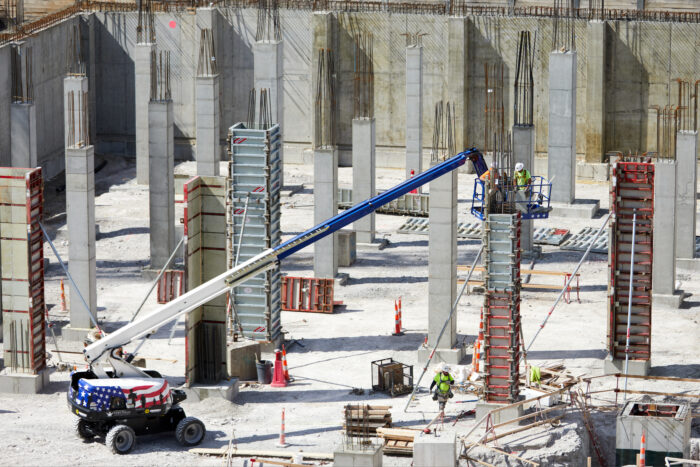
Washington University School of Medicine’s eastern border began noticeably changing in April and will look strikingly different in 2023, when the neuroscience research building — 11 stories tall and 609,000 square feet — is complete. The building project, the largest in the medical school’s history, will span almost a block in the 200-acre Cortex Innovation Community, one of the fastest-growing business, innovation and technology hubs in the United States.
The building’s basement lies in a hole 25 feet deep and 400 feet long, dug at the southeast corner of Duncan and Newstead avenues. More than 106 drilled concrete piers have been poured, and the interior columns and floor in the western half of the basement have been completed.
When the state-of-the art building at 4370 Duncan Ave. is finished, it will hold enough steel to stretch 2,125 miles, enough drywall to cover 31 football fields and enough concrete to fill 6,500 truckloads.
“This building project will connect our campus core to the Cortex Innovation Community and define the eastern edge of the Medical Campus,” said Melissa Hopkins, the school’s assistant vice chancellor and assistant dean of operations and facilities. “More importantly, it will bring together interdisciplinary neuroscience research and innovation at the School of Medicine.”
To get an idea of the project, campus visitors can see a construction mock-up in front of the Couch Biomedical Research Building. Mock-ups generally are full-size representations of sections of proposed buildings, assembled to evaluate design and construction details. When the mock-up is complete, it will consist of two 20-foot structures. One of these structures will resemble the glass three-story lobby on the north side of the neuroscience research building.
Initially, 5½ floors of the building will house 100 research teams in laboratory space, and additional shell space could be built out later for another 45 research teams. The building will feature a large seminar room on the first floor and a coffee shop with a rooftop terrace on the third floor. The terrace will provide a social space for employees and also be used for events.
In addition to the building, the project will include an 1,839-space parking garage, a pedestrian link connecting the St. Louis Children’s Hospital garage and a separate utility plant.
The building is the first facility on the Medical Campus to feature research “neighborhoods” on each floor to spur collaboration. The neighborhoods will be organized around research themes — including addiction, neurodegeneration, sleep and circadian rhythm, synapse and circuits, and neurogenomics and neurogenetics — that bring people together with common interests from multiple departments. These departments include neurology, neuroscience, neurosurgery, psychiatry and anesthesiology.
Read the full story in The Source.